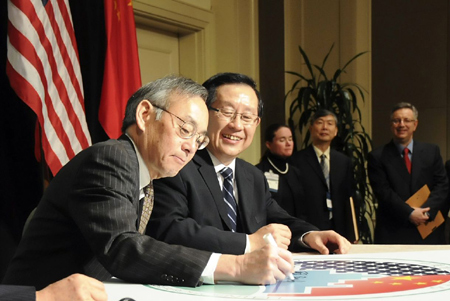-
News >Bizchina
China makes flurry of energy deals with US firms
2011-01-20 09:34
Minister of Science and Technology Wan Gang (right) and US Secretary of Energy Steven Chu sign their names on the emblem of the China-US Clean Energy Research Center, which was initiated in 2009, at the Second China-US Strategic Forum on Clean Energy Cooperation in Washington on Tuesday (Wednesday, Beijing time). [Photo / Xinhua]
Washington - China's National Energy Administration and the United States Department of Energy signed 18 deals worth $13 billion on Tuesday, ushering in President Hu Jintao's four-day state visit to the United States.
The deals coincided with the Second China-US Strategic Forum on Clean Energy Cooperation that began on Tuesday morning in Washington.
The agreements came a day after a 120-member Chinese delegation, led by Vice-Minister of Commerce Wang Chao, signed a number of agreements with businesses in Houston, Texas, worth about $600 million.
Among Tuesday's deals, Westinghouse Electric Co extended its nuclear power cooperation agreement with China's State Nuclear Power Technology Co Ltd for two years. The deal will allow Westinghouse to continue its operation of a nuclear power plant in China.
Aris Candris, CEO and president of Westinghouse, told China Daily that the development of nuclear reactors in China has created more than 5,000 jobs for the company and its supply chain in the US.
Alcoa Inc and China Power Investment Corp signed deals on a range of aluminum and clean energy projects worth about $7.5 billion.
GE Energy and China's Shenhua Group announced a venture to develop clean coal technologies in China. The Financial Times reported that GE is also signing rail and aviation deals as part of its efforts to create a larger presence in the Chinese market.
Experts from both the US and China are calling Hu's visit historic, describing the Wednesday meeting between Hu and US President Barack Obama the most important since former leader Deng Xiaoping opened ties with the US 32 years ago.
At the forum, the China-US Clean Energy Research Center, an initiative to bring together teams of Chinese and US scientists, unveiled a plan for both nations to develop new clean energy solutions and share technological advances, US Energy Secretary Steven Chu said.
Since the China-US Clean Energy Research Center was announced in November 2009, the two nations have brought some 100 universities, national laboratories and businesses together to identify key areas in clean energy research.
Under the new plan, three China-US research consortia of universities, laboratories, non-governmental organizations and businesses will delve into new technologies, practices and policies for clean vehicles, energy efficiency and advanced coal technology.
Every keynote speaker at the forum, Chinese and American, stressed the need for the two countries to cooperate in searching for new technologies to reduce their reliance on fossil fuels, cut down on carbon dioxide emissions, improve energy efficiency and develop renewable energy resources and biofuels that do not threaten food security.
Wan Gang, China's minister of science and technology, said in his speech that no country can escape the consequences of heavy reliance on fossil fuels.
Zhang Guobao, head of the National Energy Administration, said China must embark "on a low-carbon road" and increase its energy efficiency while reducing the intensity of carbon emissions per unit of GDP.Dennis N. Assanis, director of the Michigan Memorial Phoenix Energy Institute at the University of Michigan, told China Daily that his institute will collaborate with other US institutes and China's Tsinghua and Shanghai Jiao Tong universities to explore electric vehicles, battery storage, biofuels, clean combustion, and safe but lightweight vehicle structures.
In other news about energy agreements between China and the US, China's National Energy Administration, the US Department of Energy and Peking University's College of Engineering signed a letter of intent to bring the international solar decathlon to China in 2013.
During the bi-annual competition, launched in 2002, some 20 collegiate teams must design, build and operate the most attractive, effective and energy-efficient solar-powered house, according to Yu Pingrong, research professor and director of Center of Solar Energy of Peking University. The winner of the competition is the team that integrates affordability, consumer appeal and design with optimal energy production.
"I hope the competition will inspire a lot of Chinese college students to open up their minds and build their careers in developing innovative technologies and practices in renewable energy and building energy efficiency," Yu, who was the first to propose the project, told China Daily.
Lu Chang contributed to this story.
